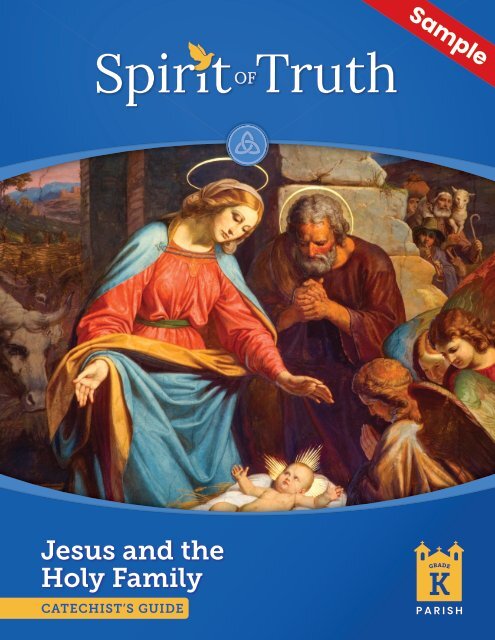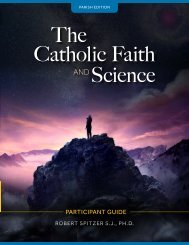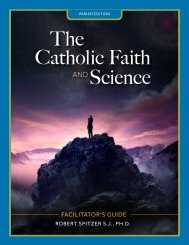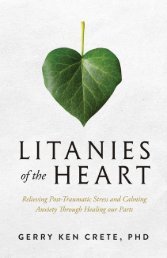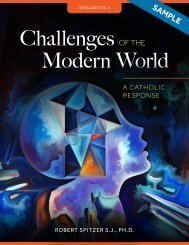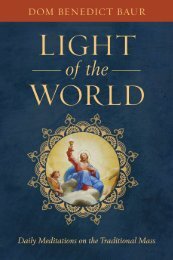You also want an ePaper? Increase the reach of your titles
YUMPU automatically turns print PDFs into web optimized ePapers that Google loves.
<strong>Sample</strong><br />
<br />
<br />
ofTruth<br />
Jesus and the<br />
Holy Family<br />
CATECHIST’S GUIDE<br />
KGRADE<br />
PARISH<br />
<br />
a
is proud to announce<br />
the second edition of<br />
ofTruth<br />
GRADES K–2<br />
The updates in our second edition reflect<br />
feedback from the catechists in 813<br />
parishes who have used Spirit of Truth<br />
since 2018. Our goal was to develop a more<br />
age-appropriate resource that preserves<br />
the completeness and beauty of the first<br />
edition. We are grateful to our team of 42<br />
teacher authors and 146 pilot catechists<br />
who have prepared and refined draft<br />
sessions in 2021/2022.<br />
This sample session includes sample<br />
Catechist’s Guide pages followed by<br />
Student Work<strong>book</strong> pages.<br />
For more information and to order, visit<br />
SophiaInstituteforTeachers.org/newK2
Session 9<br />
Jesus Loves<br />
and Heals<br />
the Sick<br />
1
Jesus Loves and Heals the Sick<br />
Session 9 at a Glance<br />
Learning Goals<br />
• In the Gospels, Jesus continually sought out the sick to help them.<br />
• Jesus shows us that He is the Son of God by healing the sick.<br />
• Jesus wants to comfort and be near us when we are sick.<br />
• We can pray and ask God to heal our friends and family.<br />
Session Plan Chart<br />
OPTION A<br />
CATECHIST’S<br />
GUIDE PAGES<br />
STUDENT<br />
WORKBOOK PAGES<br />
Warm-Up pg. 4 pg. 23<br />
Activity: Jesus Heals the Sick pg. 6 pg. 24<br />
Formative Assessment: Praise the Lord<br />
• You will need: the video at SophiaOnline.org/Hallelu<br />
pg. 8 pg. 25<br />
OPTION B<br />
Warm-Up: Who Is Jesus?<br />
• You will need: scissors, glue<br />
CATECHIST’S<br />
GUIDE PAGES<br />
pg. 10<br />
STUDENT<br />
WORKBOOK PAGES<br />
N/A<br />
Activity: Little Girl, I Say to You, Arise! pg. 13 pg. 29<br />
Formative Assessment: Little Girl, I Say to You, Arise! (continued) pg. 14 pg. 30<br />
OPTION C<br />
CATECHIST’S<br />
GUIDE PAGES<br />
STUDENT<br />
WORKBOOK PAGES<br />
Warm-Up pg. 17 N/A<br />
Activity: St. Blaise pg. 18 pg. 31<br />
Formative Assessment: Get-Well Prayer Card pg. 20 pg. 32<br />
Vocabulary Your Students Will Learn<br />
• A prophet is a person who announces that God is close to His people and proclaims God’s<br />
Promise.<br />
2<br />
Jesus Loves and Heals the Sick
Jesus Heals<br />
the Blind Man<br />
by<br />
Carl Bloch<br />
Praise the Lord<br />
Hallelu! Hallelu! Hallelu! Hallelujah!<br />
Praise ye the Lord!<br />
Little Girl,<br />
I Say to You,<br />
Write 1, 2, 3, or 4 in each circle<br />
to put the story in order<br />
Arise!<br />
Get-Well Prayer Card<br />
J esus H eals the S ick<br />
Match the pictures of the sick with<br />
the pictures of them healed<br />
Hallelu! Hallelu! Hallelu! Hallelujah!<br />
Praise ye the Lord! Who Is Jesus?<br />
Cut out the pictures 1<br />
and paste them in<br />
Praise the correct ye the spaces. Lord!<br />
Hallelujah!<br />
Then trace the path<br />
of the disciples.<br />
Praise ye the Lord!<br />
4<br />
Hallelujah!<br />
1<br />
2<br />
St. Blaise<br />
St. Blaise was a doctor and a bishop<br />
who healed the sick and the wounded.<br />
What should the little girl be given to eat?<br />
Circle your choice or draw your own food.<br />
Dear Jesus, we ask that<br />
You bless and heal<br />
_________________________<br />
You are the Messiah, the Son<br />
of God. You love us. Your<br />
will be done. We praise You.<br />
Amen.<br />
Praise ye the Lord!<br />
Hallelujah!<br />
Praise ye the Lord!<br />
2<br />
3<br />
4<br />
3<br />
Connections to the Catechism in This Session<br />
• Catechism of the Catholic Church 549<br />
• Catechism of the Catholic Church 1503–1510<br />
Key Scripture<br />
He will wipe every tear from their eyes, and there shall be no more death or mourning, wailing<br />
or pain.<br />
— Revelation 21:4<br />
He said, “Go and tell John what you have seen and heard: the blind regain their sight, the<br />
lame walk, lepers are cleansed, the deaf hear, the dead are raised, the poor have the good news<br />
proclaimed to them.”<br />
— Luke 7:22<br />
“Little Girl, I say to You, arise.”<br />
— Mark 5:41<br />
Prayer for This Session<br />
Dear Jesus, Divine Healer of the sick, we place our sick under Your care and ask that You<br />
restore them to health again. Most of all, give us the grace to remember Your will and know<br />
that whatever You do, You do for the love of us. Amen.<br />
Jesus Loves and Heals the Sick<br />
3
Jesus Loves and Heals the Sick<br />
Option A Session 9<br />
Session 9<br />
Option A<br />
Option A<br />
Warm-Up<br />
A. Begin by having your students repeat this session’s prayer after you, line by line.<br />
Dear Jesus, Divine Healer of the sick, we place our sick under Your care and ask<br />
that You restore them to health again. Most of all, give us the grace to remember<br />
Your will and know that whatever You do, You do for the love of us. Amen.<br />
B. Next, help the students remember times when they were sick or when someone in their family<br />
was sick. This will help you gauge their questions and concerns about sickness and death. Here<br />
are some guiding questions for the discussion:<br />
• What happens when you get sick?<br />
• Do you get to eat special food and get special drinks?<br />
• Has someone in your family been sick?<br />
• What made him or her feel better?<br />
Note: Your students may ask you questions about people who have died from an illness. It is up<br />
to you how to handle this topic. If it is just one child, maybe handle it individually. If many of<br />
your students have questions, you can share the Gospel message that Jesus conquered suffering<br />
and death. Even though we will still die, we will rise again and live forever. Children need to<br />
know about Heaven!<br />
23<br />
Jesus Heals<br />
the Blind Man<br />
by<br />
Carl Bloch<br />
Jesus Loves and Heals the Sick 23<br />
C. Next, have your students turn to Jesus Heals (page 23 in the Student<br />
Work<strong>book</strong>). Tell them to look at the painting for a few minutes in silence.<br />
After a minute ask your students the following questions:<br />
• What do you like about this painting? Accept reasoned answers.<br />
• Do you recognize any of the people in this painting? Jesus<br />
• Who is Jesus speaking to? A blind man<br />
• What is Jesus doing? Holding out his hand or healing the man.<br />
• What are the other people in the picture doing? Watching Jesus.<br />
• Would you like see Jesus heal the blind man? Yes.<br />
D. Wrap up the discussion by explaining to your students that Jesus came to save us so that<br />
suffering and death are temporary. Jesus conquered suffering and death for us. And even<br />
though they still exist right now, they will not exist in Heaven: “He will wipe every tear from<br />
their eyes, and there shall be no more death or mourning, wailing or pain” (Revelation 21:4).<br />
4<br />
Jesus Loves and Heals the Sick
Option A Session 9<br />
Warm-Up Worksheet<br />
(page 23 in the Student Work<strong>book</strong>)<br />
Option A Session 9<br />
Jesus Heals<br />
the Blind Man<br />
by<br />
Carl Bloch<br />
Jesus Loves and Heals the Sick<br />
23<br />
Jesus Loves and Heals the Sick<br />
5
Session 9<br />
Option A<br />
OPTION A > Activity: Jesus Heals the Sick<br />
J esus H eals the S ick<br />
Match the pictures of the sick with<br />
the pictures of them healed<br />
A. Next, have your students turn to Jesus Heals the Sick (page 24 in the<br />
Student Work<strong>book</strong>).<br />
B. Explain to the children that Jesus loves the sick especially. He promised<br />
to send comfort and peace to all the sick and suffering. Briefly tell<br />
the following stories of the three people Jesus healed in the Gospels.<br />
Optionally, you may want to pause between each story in order to let your<br />
students find the correct pictures and match them.<br />
C. When Jesus was teaching everyone about the love of God, many sick people<br />
came to Him to be healed. Read aloud to your students these three stories<br />
about Jesus:<br />
Story 1: There was a blind man who was sitting in the road and was yelling very loudly,<br />
“Jesus, Son of David, have mercy on me, a sinner.” Everyone around him told the blind man<br />
to be quiet and stop shouting. But Jesus stopped and asked, “What do you want me to do for<br />
you?” And the blind man answered, “Lord, please help me see.” Jesus told him, “Have sight.<br />
Your faith has saved you.” And immediately, the blind man could see and began praising<br />
and giving glory to God. Everyone around him saw this healing and began to praise God!<br />
(paraphrase of Luke 18:35–43)<br />
Story 2: When Jesus went into a synagogue, He saw a man with a withered hand. His<br />
hand was misshapen and skinny. Many people knew that Jesus could cure him, but they<br />
didn’t want Jesus to do it because it was the day of rest. But Jesus was sad that they didn’t<br />
understand that it is always right to do good things every day. So, he said to the man with<br />
the withered hand, “Stretch out your hand,” And the man stretched it out, and it was strong<br />
and whole. Jesus healed the man and taught us that we should praise the Lord and do good<br />
things every day. (paraphrase of Mark 3:1–6)<br />
Story 3: Once when Jesus was teaching about the love of God, He was in a crowded house.<br />
It was so crowded that no one could get in through the door. But there was a sick man who<br />
could not use his arms and legs. His friends had to help him get close to Jesus by lowering<br />
him on a stretcher through an opening in the roof. Jesus saw the man lying on the stretcher<br />
and said, “Your sins are forgiven.” Now, in the room were people who did not believe Jesus<br />
could forgive sins and started grumbling. So Jesus decided to show them that He could<br />
forgive sins and show them that He could heal the man’s body too. And He said to the man<br />
on the stretcher, “I say to you, rise, pick up your stretcher, and go home.” And the man got<br />
up, and picked up his stretcher, and went home glorifying and praising God.<br />
D. After they have listened to the stories, the students can trace the letters for Jesus Heals the Sick,<br />
and if they have not done it before now, can match the pictures that retell each story.<br />
6<br />
Jesus Loves and Heals the Sick
Option A Session 9<br />
Activity Worksheet<br />
(page 24 in the Student Work<strong>book</strong>)<br />
Session 9<br />
Option A<br />
J esus H eals the S ick<br />
Match the pictures of the sick with<br />
the pictures of them healed<br />
24 Jesus Loves and Heals the Sick Jesus Loves and Heals the Sick<br />
7
Session 9<br />
Option A<br />
OPTION A > Formative Assessment<br />
A. After the students have finished the worksheet, ask them what each of the healed people did<br />
right after they had been healed. They praised God.<br />
B. What should we do after Jesus heals us from sickness or offers us comfort when we are sick?<br />
We should praise God.<br />
Praise the Lord<br />
Hallelu! Hallelu! Hallelu! Hallelujah!<br />
Praise ye the Lord!<br />
Hallelu! Hallelu! Hallelu! Hallelujah!<br />
Praise ye the Lord!<br />
Praise ye the Lord!<br />
Hallelujah!<br />
Praise ye the Lord!<br />
Hallelujah!<br />
Praise ye the Lord!<br />
Hallelujah!<br />
Praise ye the Lord!<br />
C. Next, tell the children that they are going to learn a song of praise for God.<br />
Here are the lyrics, which also appear on their work<strong>book</strong> on Praise the Lord<br />
(page 25 in the Student Work<strong>book</strong>):<br />
Hallelu! Hallelu! Hallelu! Hallelujah!<br />
Praise ye the Lord!<br />
Hallelu! Hallelu! Hallelu! Hallelujah!<br />
Praise ye the Lord!<br />
Praise ye the Lord! Hallelujah!<br />
Praise ye the Lord! Hallelujah!<br />
Praise ye the Lord! Hallelujah!<br />
Praise ye the Lord!<br />
Optional Video<br />
Optionally you could show this version with a teacher and children from England,<br />
found at Sophiaonline.org/Hallelu<br />
8<br />
Jesus Loves and Heals the Sick
Option A Session 9<br />
Formative Assessment Worksheet<br />
(page 25 in the Student Work<strong>book</strong>)<br />
Option A Session 9<br />
Praise the Lord<br />
Hallelu! Hallelu! Hallelu! Hallelujah!<br />
Praise ye the Lord!<br />
Hallelu! Hallelu! Hallelu! Hallelujah!<br />
Praise ye the Lord!<br />
Praise ye the Lord!<br />
Hallelujah!<br />
Praise ye the Lord!<br />
Hallelujah!<br />
Praise ye the Lord!<br />
Hallelujah!<br />
Praise ye the Lord!<br />
Jesus Loves and Heals the Sick<br />
25<br />
Jesus Loves and Heals the Sick<br />
9
Session 9<br />
Option B<br />
Option B<br />
Warm-Up<br />
A. Begin by leading your students in the prayer for this session.<br />
Dear Jesus, Divine Healer of the sick, we place our sick under Your care and ask<br />
that You restore them to health again. Most of all, give us the grace to remember<br />
Your will and know that whatever You do, You do for the love of us. Amen.<br />
B. Remind the students that Jesus heals the sick and promises that He will always be near us.<br />
Jesus did this in the Gospel both to show people that He is God and promise them that He was<br />
going to save them from their sins by dying and rising from the dead. Jesus is the Messiah.<br />
Thousands of years before Jesus was born, God promised that the Messiah would come. And<br />
everyone was wondering if Jesus was truly the Messiah.<br />
Who Is Jesus?<br />
Cut out the pictures<br />
and paste them in<br />
the correct spaces.<br />
Then trace the path<br />
of the disciples.<br />
3<br />
4<br />
2<br />
1<br />
2<br />
3<br />
4<br />
1<br />
C. Next, have your students turn to Who Is Jesus? (page 26 in the Student<br />
Work<strong>book</strong>), which tells the story of John the Baptist’s disciples asking Jesus<br />
if He is the Messiah and returning with the message. To start, introduce the<br />
students to John the Baptist.<br />
D. Explain to your students that John the Baptist was the greatest of the<br />
prophets. Prophets are people who announce that God is close to His<br />
people and proclaim God’s promises. John the Baptist was also Jesus’<br />
cousin, and even before he was born, he knew that Jesus was the Son<br />
of God and would save all people from sickness, suffering, and sin. Even<br />
before he was born, John leaped for joy because Jesus was near. But not<br />
everyone knew this.<br />
E. Before you begin, have the students cut out the disciples from pg. 27, or you can glue them<br />
to popsicle sticks.<br />
F. Have your students find the 1 on their sheet. Tell them that John told his disciples to go ask<br />
Jesus who He was so that they would know Jesus was God. Have the students find the number<br />
2 , where Jesus is with His disciples. The disciples asked Jesus, “Who are you?” And Jesus said<br />
something mysterious. Read aloud to your students what Jesus said:<br />
He said, “Go and tell John what you have seen and heard: the blind regain their sight, the<br />
lame walk, lepers are cleansed, the deaf hear, the dead are raised, the poor have the good<br />
news proclaimed to them.” (Luke 7:22)<br />
G. Have your students find 3 : the disciples return to John and tell him the good news.<br />
H. Have them move to 4 : and John rejoiced because now his disciples knew that Jesus was the<br />
Messiah.<br />
10<br />
Jesus Loves and Heals the Sick
Option B Session 9<br />
Warm-Up Worksheet<br />
(page 26 in the Student Work<strong>book</strong>)<br />
Session 9<br />
Option B<br />
Who Is Jesus?<br />
Cut out the pictures<br />
and paste them in<br />
the correct spaces.<br />
1<br />
Then trace the path<br />
of the disciples.<br />
2<br />
26 Jesus Loves and Heals the Sick Jesus Loves and Heals the Sick<br />
11
Session 9<br />
Option B<br />
Warm-Up Worksheet<br />
(page 27 in the Student Work<strong>book</strong>)<br />
Option B Session 9<br />
1<br />
4<br />
2<br />
3<br />
4<br />
3<br />
Jesus Loves and Heals the Sick<br />
27<br />
12<br />
Jesus Loves and Heals the Sick
Option B Session 9<br />
OPTION B ><br />
Little Girl,<br />
I Say to You,<br />
Write 1, 2, 3, or 4 in each circle<br />
to put the story in order<br />
Arise!<br />
Activity<br />
A. Have your students turn to Little Girl, I Say to You, Arise! (page 29 in the<br />
Student Work<strong>book</strong>). Ask them who is in the picture. Ask them what they<br />
think Jesus is saying to the little girl.<br />
What should the little girl be given to eat?<br />
Circle your choice or draw your own food.<br />
B. Next, read aloud to your students the story of Jesus raising the little girl<br />
from the dead from Mark 5:35–43. While you are reading, they can color the<br />
picture and trace the powerful words of Jesus. There are three sight words<br />
that your students can trace. You may want to discuss them at this point or<br />
later.<br />
A man named Jairus asked Jesus to save his daughter from a very serious sickness. While<br />
he was asking Jesus for help, people came to tell him that his daughter had died. But Jesus<br />
said, “Do not be afraid; just have faith.” Jesus went to Jairus’ house and went inside. He saw<br />
all the people around weeping and wailing, and he said to them, “Why this commotion and<br />
weeping? The child is not dead but asleep.” And the people who were wailing and weeping<br />
started to make fun of Jesus and not believe in Him. So He told them to go out and went<br />
into the little girl’s room. Only her father and her mother and Jesus’ disciples were in the<br />
room. Jesus took the little girl by the hand and said, “Talitha koum,” which means, “Little girl,<br />
I say to you arise.” And the little girl, who had been so sick and so still, got up and started<br />
walking around. Everyone was shocked and speechless, and Jesus said that she should be<br />
given something to eat.<br />
C. When you have finished reading the story, encourage a few students to retell the story in their<br />
own words by looking at the picture. Help them say the words of Jesus, “Talitha koum” which<br />
is pronounced “Talita koom” and means in Aramaic, “Little girl, I say to you, arise.” Explain that<br />
Jesus’ words have the power to erase sickness and death. Jesus’ words always have that power.<br />
The power of Jesus’ words today are in the sacraments.<br />
Jesus Loves and Heals the Sick<br />
13
Session 9<br />
Option B<br />
OPTION B ><br />
Formative Assessment<br />
A. Ask one or two students to retell the story of Jairus’ daughter. You may want to let them act it<br />
out once or twice. Some students can play the parts of the parents, others can play the wailing<br />
people, one student can be Jesus, and another can be the little girl. At the end of the story, Jesus<br />
tells them to give the little girl something to eat.<br />
B. Have your students turn to page 30 in the Student Work<strong>book</strong> and put the story in order, and<br />
then circle or draw a picture of what this little girl would eat as her first meal after being sick.<br />
A Note about Meditating on Scripture<br />
When meditating and praying with Scripture, it is important to associate it with<br />
concrete images. Although the detail of being given something to eat might seem<br />
trivial, it is a concrete image for the students to connect with their experience with<br />
the little girl. And many spiritual commentators identify these words of Jesus as an<br />
allusion to the mystery of the Eucharist. For the students, however, their memory<br />
of recovering from illness will very likely involve food. So the exercise here is to<br />
reinforce that this little girl was truly healed and truly brought back to life because<br />
of Jesus.<br />
14<br />
Jesus Loves and Heals the Sick
Option B Session 9<br />
Activity Worksheet<br />
(page 29 in the Student Work<strong>book</strong>)<br />
Option B Session 9<br />
Little Girl,<br />
I Say to You,<br />
Arise!<br />
Jesus Loves and Heals the Sick<br />
29<br />
Jesus Loves and Heals the Sick<br />
15
Session 9<br />
Option B<br />
Activity Worksheet, continued<br />
(page 30 in the Student Work<strong>book</strong>)<br />
Session 9<br />
Option B<br />
Write 1, 2, 3, or 4 in each circle<br />
to put the story in order<br />
3 1 4 2<br />
What should the little girl be given to eat?<br />
Circle your choice or draw your own food.<br />
30<br />
Jesus Loves and Heals the Sick<br />
16<br />
Jesus Loves and Heals the Sick
Option C Session 9<br />
Option C<br />
Warm-Up<br />
A. Begin by leading your students in the prayer for this session.<br />
Dear Jesus, Divine Healer of the sick, we place our sick under Your care and ask<br />
that You restore them to health again. Most of all, give us the grace to remember<br />
Your will and know that whatever You do, You do for the love of us. Amen.<br />
B. Next, explain to your students that you are going to play a game from a story from the Bible.<br />
• You, the catechist, are going to pretend to be a very grumpy judge who is asleep and doesn’t<br />
like to be wakened.<br />
• One student is going to come up to your desk and knock very loudly.<br />
• You should wake up loudly with a blustery voice and ask, “Who is that?”<br />
• The student should tell you that she is poor and needs justice.<br />
• You tell that student to go away.<br />
• Each student should have a turn playing the widow and coming up. The more blustery you<br />
tell them to go away, the better.<br />
• When the last student, or the last student you have time for, comes up to your desk, you<br />
should get up and say, “Okay, okay, I will give you justice; just let me sleep!”<br />
C. Explain that Jesus told His disciples this story and that the judge was a grumpy old man<br />
and after the woman knocked over and over and over again, he got up and gave her what<br />
she wanted. But God is not a grumpy old man. He is greater and better than any man, and<br />
He is our Father, who loves us, and so we can keep knocking, knowing that He will always<br />
get up and hear our prayers right away.<br />
Jesus Loves and Heals the Sick<br />
17
Session 9<br />
Option C<br />
OPTION C ><br />
Activity<br />
A. Start by explaining to your students that when Jesus went to be with His Father in Heaven,<br />
He gave the apostles and the saints the ability to heal in His name. All the apostles and<br />
many of the saints ask Jesus for us to be healed. They are just like the woman who knocked.<br />
One of these saints was St. Blaise.<br />
St. Blaise<br />
St. Blaise was a doctor and a bishop<br />
who healed the sick and the wounded.<br />
B. Next, have your students turn to the picture of St. Blaise (page 31 in the<br />
Student Work<strong>book</strong>). Have your students color the picture while you read<br />
aloud the story of St. Blaise.<br />
If you go to church on February 3, your priest might give the<br />
blessing of the throats after Mass. He will hold two crossed candles<br />
(the candles were blessed during the feast of the Presentation,<br />
which celebrates when Mary and Joseph offered Jesus to God<br />
in the Temple) to your throat and say these words: “Through the<br />
intercession of St. Blaise, bishop and martyr, may God deliver you<br />
from every disease of the throat and from every other illness: in<br />
the name of the Father, and of the Son, and of the Holy Spirit.”<br />
St. Blaise was a doctor who healed the sick and the wounded. He<br />
lived in ancient Armenia which is now called Turkey. But he felt<br />
called by God to heal a different kind of sickness, the sickness of<br />
the soul. St. Blaise became a bishop so he could heal the wounds of<br />
souls by ministering the sacraments.<br />
St. Blaise was put in jail because he would not pretend that a<br />
false god was God. While he was in jail, an upset woman brought<br />
her son to the jail cell. A fishbone was stuck in the boy’s throat. The<br />
terrified mother worried that her son would choke to death. She<br />
begged St. Blaise for help. She knew he was a holy man and that<br />
God would listen to his prayers. St. Blaise felt compassion for the<br />
mother and her boy. He prayed to God for a cure, and God listened<br />
to his prayer. The boy was healed, and his mother cried tears of joy.<br />
St. Blaise, protect me from all sickness, in particular sickness of<br />
the throat.<br />
18<br />
Jesus Loves and Heals the Sick
Option C Session 9<br />
Activity Worksheet<br />
(page 31 in the Student Work<strong>book</strong>)<br />
Option C Session 9<br />
St. Blaise<br />
St. Blaise was a doctor and a bishop<br />
who healed the sick and the wounded.<br />
Jesus Loves and Heals the Sick<br />
31<br />
Jesus Loves and Heals the Sick<br />
19
Session 9<br />
Option C<br />
OPTION C ><br />
Formative Assessment<br />
A. Tell your students that they are going to make a get-well prayer card to give to someone who is<br />
sick. The card will tell the person that Jesus loves him or her and that they will pray for Jesus to<br />
heal him or her.<br />
Get-Well Prayer Card<br />
Dear Jesus, we ask that<br />
You bless and heal<br />
_________________________<br />
You are the Messiah, the Son<br />
of God. You love us. Your<br />
will be done. We praise You.<br />
B. Have the students turn to Get-Well Prayer Card (page 32 in the Student<br />
Work<strong>book</strong>). They can decorate the outside edge of the card with all their<br />
favorite things. And in the middle they should write the name of the person<br />
they are praying for.<br />
Amen.<br />
20<br />
Jesus Loves and Heals the Sick
Option C Session 9<br />
Formative Assessment Worksheet<br />
(page 32 in the Student Work<strong>book</strong>)<br />
Session 9<br />
Option C<br />
Get-Well Prayer Card<br />
Dear Jesus, we ask that<br />
You bless and heal<br />
_________________________<br />
You are the Messiah, the Son<br />
of God. You love us. Your<br />
will be done. We praise You.<br />
Amen.<br />
32<br />
Jesus Loves and Heals the Sick<br />
Jesus Loves and Heals the Sick<br />
21
STUDENT<br />
WORKBOOK<br />
<strong>Sample</strong> pages
Option A Session 9<br />
Jesus Heals<br />
the Blind Man<br />
by<br />
Carl Bloch<br />
Jesus Loves and Heals the Sick<br />
23
Session 9<br />
Option A<br />
J esus H eals the S ick<br />
Match the pictures of the sick with<br />
the pictures of them healed<br />
24<br />
Jesus Loves and Heals the Sick
Option A Session 9<br />
Praise the Lord<br />
Hallelu! Hallelu! Hallelu! Hallelujah!<br />
Praise ye the Lord!<br />
Hallelu! Hallelu! Hallelu! Hallelujah!<br />
Praise ye the Lord!<br />
Praise ye the Lord!<br />
Hallelujah!<br />
Praise ye the Lord!<br />
Hallelujah!<br />
Praise ye the Lord!<br />
Hallelujah!<br />
Praise ye the Lord!<br />
Jesus Loves and Heals the Sick<br />
25
Session 9<br />
Option B<br />
Who Is Jesus?<br />
Cut out the pictures<br />
and paste them in<br />
the correct spaces.<br />
1<br />
Then trace the path<br />
of the disciples.<br />
2<br />
26<br />
Jesus Loves and Heals the Sick
Option B Session 9<br />
1<br />
4<br />
2<br />
3<br />
4<br />
3<br />
Jesus Loves and Heals the Sick<br />
27
Session 9<br />
Option B<br />
28<br />
Jesus Loves and Heals the Sick
Option B Session 9<br />
Little Girl,<br />
I Say to You,<br />
Arise!<br />
Jesus Loves and Heals the Sick<br />
29
Session 9<br />
Option B<br />
Write 1, 2, 3, or 4 in each circle<br />
to put the story in order<br />
What should the little girl be given to eat?<br />
Circle your choice or draw your own food.<br />
30<br />
Jesus Loves and Heals the Sick
Option C Session 9<br />
St. Blaise<br />
St. Blaise was a doctor and a bishop<br />
who healed the sick and the wounded.<br />
Jesus Loves and Heals the Sick<br />
31
Session 9<br />
Option C<br />
Get-Well Prayer Card<br />
Dear Jesus, we ask that<br />
You bless and heal<br />
_________________________<br />
You are the Messiah, the Son<br />
of God. You love us. Your<br />
will be done. We praise You.<br />
Amen.<br />
32<br />
Jesus Loves and Heals the Sick
A division of<br />
SOPHIA INSTITUTE PRESS<br />
www.SophiaInstitute.com


